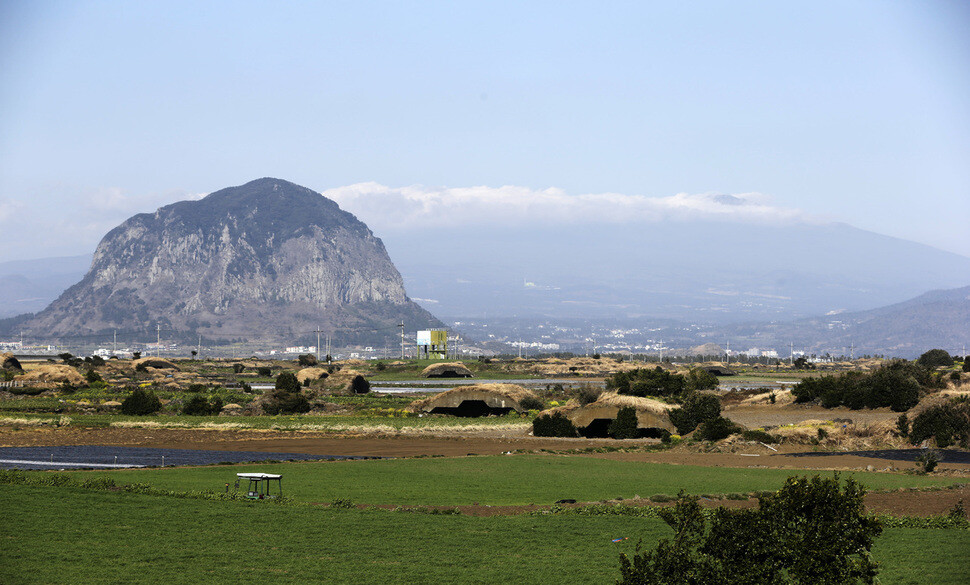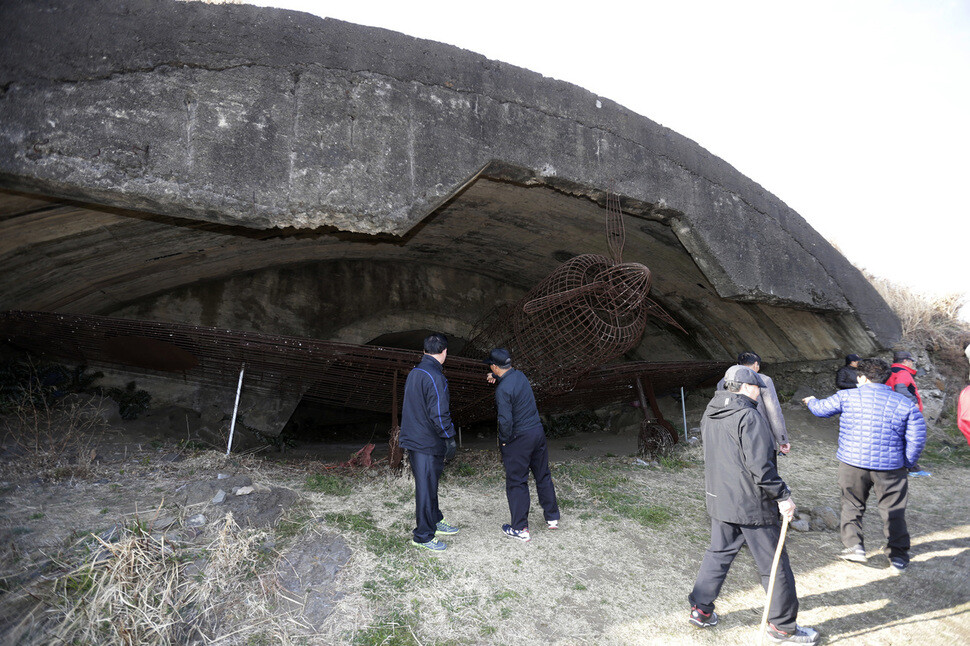hankyoreh
Links to other country sites 다른 나라 사이트 링크
[Reporter’s notebook] Vestiges of forced labor still remain on Jeju Island

“My father, my big brother, and I went to Altteureu together and dug caves on Songak Mountain, sleeping at a hamba (a Japanese term for a makeshift dormitory for laborers). When I was 15, I was doing tough pickaxe work and I got a bad injury to my forehead.” This was how the late Kim Seong-bang related his experience a decade or so ago when I was doing a story on people forcibly mobilized for labor during the Japanese occupation. Then 77 years old, the resident of Jeju’s Hallim township still bore the scar on his forehead.
“Altteureu” is the name of the area around Songak Mountain in the Daejeong township of Seogwipo City on Jeju Island. Its name is a combination of the Jeju dialect words “al,” meaning “lower,” and “deureu,” meaning “field.” A broad expanse of farmland by the coast, it is one of the best remaining examples of the vestiges of war and the ambitions of the Japanese empire’s war of conquest. The empire used it as an air base for Chinese bombing during the Sino-Japanese War that began in 1937; in the later stages of the Pacific War, it built various military facilities there, including an airfield to block the US advance on the Japanese mainland.
As part of this process, Jeju residents were drafted on a permanent basis to build airfields, hardened sites, and bunkers as well as make other war preparations. Whole families were occasionally mobilized, as in Kim’s case, and residents sometimes served by proxy, such as young children substituting for fathers who had to do farming. In one case, three brothers were drafted into military or labor service at different sites in Japan and on Jeju Island. Often, laborers were injured when hangars collapsed during construction or the roof caved in while a hardened site was being excavated.
“After the Sino-Japanese War broke out, there was an expansion of the Altteureu air field. During the busy far season, you’d have 50 or so people going there to live and work. Every week, they’d have to rotate out, and the same number of people would have to come in and take their place. They had to keep doing this for three years straight, but it was all by shovel and pickaxe, so they never did finish it all.”
Daejeong resident Moon Sang-jin, now 92, was mobilized to work on the Altteureu air field for three years at the age of 17. After the Battle of Okinawa between US and Japanese forces in 1945, he was mobilized alongside Japanese soldiers to smooth down the slope of Songak Mountain so that US troops that landed there would not be able to send tanks up. The project was still under way when Korea was liberated.
The Japanese empire, which saw the entire island of Jeju as an operational zone, drafted not only local residents but people from other regions from the Korean Peninsula to build its military facilities. In one incident following liberation, 118 miners from the Ongmae Mine in South Jeolla Province’s Haenam County were heading home by boat after being drafted to work on Jeju, when the vessel sank due to a still-unexplained fire.
A “tochika” encampment (a concrete structure with holes for firing weapons) on Halla Mountain’s volcanic cone was built by Jeju conscripts. Harsh treatment was routine.
“There wasn’t a single Korean who wasn’t beaten by the Japanese forces. The soldiers overseeing the workers would lay into you if they so much as heard you using Korean. They’d also call out to people at night while we were sleeping in the barracks. If you didn’t answer the first time, they’d slap you for being ‘mentally negligent’; if you did answer right away, they’d say you were ‘trying to escape’ and beat you up. They’d grab a work boot with both hands and hit your face so hard that your face would swell up the next day and you couldn’t even open your eyes all the way.”

This was the account of a resident mobilized to work on Halla Mountain’s volcanic cone as one of the first group of conscripts with the Japanese forces.
Estimates put the number of Jeju residents drafted during the Japanese occupation at over 1,700. But the number forcibly mobilized most likely fell in the tens of thousands, if those “mobilized within the province” are factored in. The entire island from Halla Mountain to the coast is essentially a museum of forced mobilization. The absence of any monuments testifying to this history is a mark of shame for a place that prides itself on being an “island of peace.”
Perhaps Altteureu, a place where so many residents spilled their blood and sweat, would be a good location for a monument to remember the forced mobilization?
Last July, the local Jeju headquarters of the Korean Confederation Trade Unions (KCTU) and civic groups launched a committee to set up a statue depicting one of the workers drafted in Jeju during the Japanese occupation. The sculpture is scheduled for raising this October.
By Huh Ho-joon, Jeju correspondent
Please direct questions or comments to [english@hani.co.kr]

Editorial・opinion
![[Guest essay] Amending the Constitution is Yoon’s key to leaving office in public’s good graces [Guest essay] Amending the Constitution is Yoon’s key to leaving office in public’s good graces](https://flexible.img.hani.co.kr/flexible/normal/500/300/imgdb/original/2024/0416/8917132552387962.jpg) [Guest essay] Amending the Constitution is Yoon’s key to leaving office in public’s good graces
[Guest essay] Amending the Constitution is Yoon’s key to leaving office in public’s good graces![[Editorial] 10 years on, lessons of Sewol tragedy must never be forgotten [Editorial] 10 years on, lessons of Sewol tragedy must never be forgotten](https://flexible.img.hani.co.kr/flexible/normal/500/300/imgdb/original/2024/0416/8317132536568958.jpg) [Editorial] 10 years on, lessons of Sewol tragedy must never be forgotten
[Editorial] 10 years on, lessons of Sewol tragedy must never be forgotten- [Column] A death blow to Korea’s prosecutor politics
- [Correspondent’s column] The US and the end of Japanese pacifism
- [Guest essay] How Korea turned its trainee doctors into monsters
- [Guest essay] As someone who helped forge Seoul-Moscow ties, their status today troubles me
- [Editorial] Koreans sent a loud and clear message to Yoon
- [Column] In Korea’s midterm elections, it’s time for accountability
- [Guest essay] At only 26, I’ve seen 4 wars in my home of Gaza
- [Column] Syngman Rhee’s bloody legacy in Jeju
Most viewed articles
- 1[Guest essay] How Korea turned its trainee doctors into monsters
- 2[Column] A death blow to Korea’s prosecutor politics
- 3[News analysis] Watershed augmentation of US-Japan alliance to put Korea’s diplomacy to the test
- 4‘National emergency’: Why Korean voters handed 192 seats to opposition parties
- 5[Photo] Cho Kuk and company march on prosecutors’ office for probe into first lady
- 6Exchange rate, oil prices, inflation: Can Korea overcome an economic triple whammy?
- 7After Iran’s attack, can the US stop Israel from starting a regional war?
- 8US grants Samsung up to $6.4B in subsidies for its chip investments there
- 9[Guest essay] Amending the Constitution is Yoon’s key to leaving office in public’s good graces
- 10Student made first call for rescue from sinking Sewol ferry